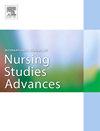为糖尿病患者开发和验证简明糖尿病足风险筛查量表
IF 3.1
Q1 NURSING
International Journal of Nursing Studies Advances
Pub Date : 2024-08-05
DOI:10.1016/j.ijnsa.2024.100230
引用次数: 0
摘要
方法 在中国长沙选取 390 名成年糖尿病患者进行研究。研究分两个阶段进行。在第一阶段,通过合并现有的糖尿病足风险筛查工具和小组讨论,制定了初步的项目。此外,糖尿病足专家还在这一阶段确定了内容的有效性。第二阶段,通过项目分析、探索性因子分析、确认性因子分析、Cronbach's alpha 系数、重测信度、评分者间信度、ROC 曲线和 AUC 等多种方法对所开发项目的效度和信度进行评估。对该量表进行了探索性因子分析,结果显示有 6 个主因子,占总方差的 74.139%。I-CVI 大于 0.8,表明内容效度良好,而 S-CVI 为 0.737。确认性因素分析表明模型拟合良好。量表的 Cronbach's α 系数为 0.770,表明其内部一致性良好,测试-再测信度为 0.958。AUC表明,糖尿病足风险简易筛查量表是识别糖尿病足的有效工具。本文章由计算机程序翻译,如有差异,请以英文原文为准。
Development and validation of a brief diabetic foot risk screening scale for diabetic patients
Objective
To develop a concise screening tool for diabetic foot risk assessment in patients with diabetes, and rigorously evaluate its reliability and validity.
Methods
390 adults diagnosed with diabetes were selected for a study in Changsha, China. The study was conducted in two phases. In the first phase, initial items were developed by amalgamating existing diabetic foot risk screening tools and group discussions. Additionally, diabetic foot experts established content validity during this phase. In the second phase, the validity and reliability of the developed items were evaluated through various methods such as item analysis, exploratory factor analysis, confirmatory factor analysis, Cronbach's alpha coefficient, retest reliability, inter-rater reliability, ROC curve and AUC.
Results
The Brief Diabetic Foot Risk Screening Scale consists of 6 dimensions and 19 items. An exploratory factor analysis was conducted on the scale, revealing six principal factors that accounted for 74.139 % of the total variance. The I-CVI was greater than 0.8, indicating good content validity, while the S-CVI was 0.737. Confirmatory factor analysis showed that the model fit well. The scale's Cronbach's α coefficient was 0.770, indicating good internal consistency, and its test-retest reliability was 0.958. The AUC suggests that the Brief Diabetic Foot Risk Screening Scale is an effective measure for identifying diabetic foot.
Conclusion
The Scale is a reliable and valid tool for assessing foot risk.
求助全文
通过发布文献求助,成功后即可免费获取论文全文。
去求助
来源期刊

International Journal of Nursing Studies Advances
Nursing-General Nursing
CiteScore
5.80
自引率
0.00%
发文量
45
审稿时长
81 days
 求助内容:
求助内容: 应助结果提醒方式:
应助结果提醒方式:


